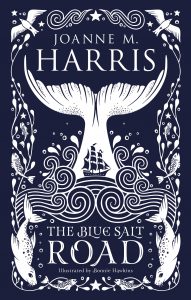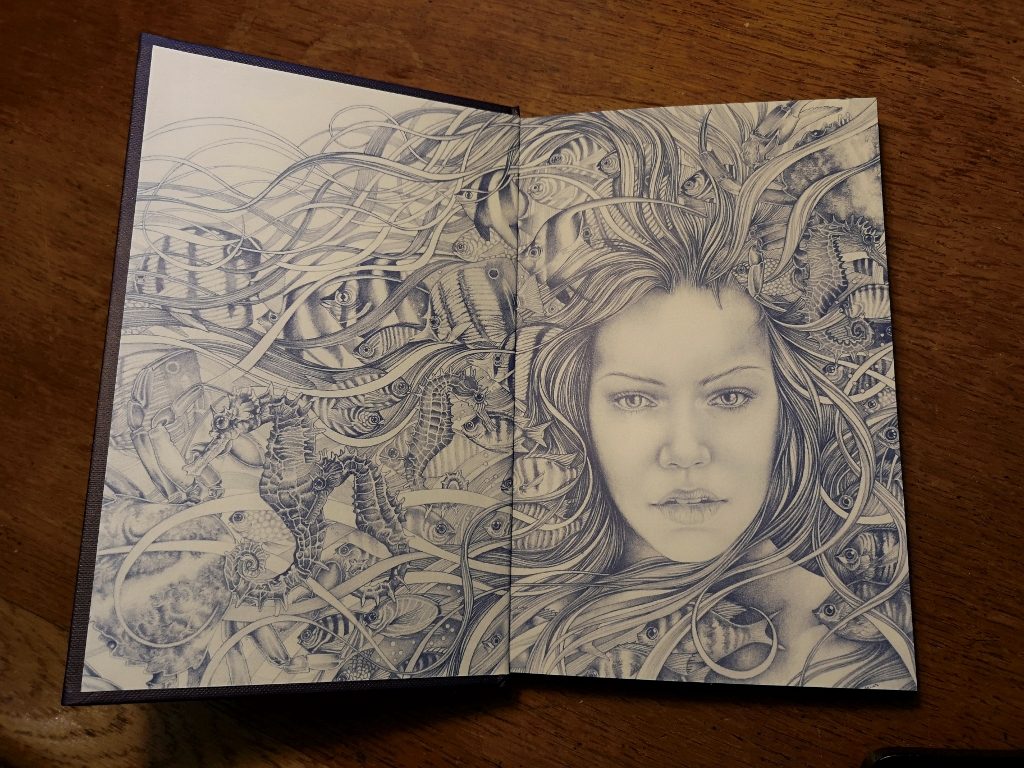 The Blue Salt Road
The Blue Salt Road
written by Joanne M. Harris
cover by Sue Gent
illustrations by Bonnie Helen Hawkins
published by Gollancz November 15th 2018
215 pages in hardback with both full page and inset illustrations
crammed with beauty, violence and revolt
Summary from publisher’s website
An earthly nourris sits and sings
And aye she sings, “Ba lilly wean,
Little ken I my bairn’s father,
Far less the land that he staps in.
(Child Ballad, no. 113)
So begins a stunning tale of love, loss and revenge, against a powerful backdrop of adventure on the high seas, and drama on the land. The Blue Salt Road balances passion and loss, love and violence and draws on nature and folklore to weave a stunning modern mythology around a nameless, wild young man.
Passion drew him to a new world, and trickery has kept him there – without his memories, separated from his own people. But as he finds his way in this dangerous new way of life, so he learns that his notions of home, and your people, might not be as fixed as he believed.
A reader’s perspective
For this reader, The Blue Salt Road could not be more welcome in my harbour of a library. I love selkies (I have written a children’s story about a boy whose mother was one), I love folklore and I love Joanne M. Harris’s lyrical writing. I was delighted, and just a little jealous, when I learned she was writing a selkie tale – and that Bonnie Helen Hawkins was illustrating it.
Sue Gent’s cover is also gorgeous – silver on dark blue – and sits beautifully alongside A Pocket Full of Crows, with its gold and black. I believe there is to be a third novella inspired by the Child Ballads – which is a happy thought for this voracious reader of folklore.
As with all the Child Ballads, don’t expect the underlying tale to be a jolly ditty typical of the merry singing peasants of Hollywood. Ballads are dark beasts, crammed with eeriness, beauty, violence and revolt. A Pocket Full of Crows was all of that – and so is The Blue Salt Road.
The exquisite pencil illustrations by Bonnie Helen Hawkins (who ought to be in a ballad with that name) ground the story in reality and yet add to its strange loveliness. Both artist and writer know the natural world well and pick up on precise details which embellish the book. It is the story that matters, though.
Complex, twisting between sorrowing and joyful like a seal wounded chasing after salmon, I can’t say more for fear of spoilers. The important point is that the original ballad has been transformed into something new and wondrous. If you love Margo Lanagan’s The Brides of Rollrock Island or Franny Billingsley’s The Folk Keeper, then this is definitely for you.

Endpapers of The Blue Salt Road drawn by Bonnie Helen Hawkins
A Writer and Editor’s VieW
Aspects I want to learn from:
- using traditional material in a new way so readers can see it differently
- adapting folk sources in a way that keeps them alive
- telling a full story in a short space
Elements I want to see more of:
- beautifully produced books
- story and image working like melody and harmony
- humans’ place in the natural world as a theme – without preaching
Bonus for your enjoyment – a haunting version of the The Great Silkie of Sule Skerry (another version of Child Ballad 113) sung by Julie Fowlis and The Unthanks:
